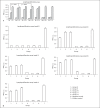Enhanced induction of SARS-CoV nucleocapsid protein-specific immune response using DNA vaccination followed by adenovirus boosting in BALB/c mice
- PMID: 16809936
- PMCID: PMC7179534
- DOI: 10.1159/000094247
Enhanced induction of SARS-CoV nucleocapsid protein-specific immune response using DNA vaccination followed by adenovirus boosting in BALB/c mice
Abstract
Objective: To investigate immunogenicity in the induction of humoral and cellular immune responses to genetic vaccines of the recombinant severe acute respiratory syndrome-associated coronavirus (SARS-CoV)-N gene expressing the same protein plasmid, pcDNA3.1-N, and replication-defective adenoviral vector, rAd-N, in a pcDNA3.1-N prime-rAd-N boost regimen and the reverse sequence in a rAd-N prime-pcDNA3.1-N boost regimen.
Method: After the mice had been immunized intramuscularly and/or intraperitoneally with pcDNA3.1-N and rAd-N in prime-triple boost immunization, humoral and cellular immune responses were detected.
Results: After detection, different levels of anti-N humoral and cellular responses are shown compared to controls. The humoral immune response was induced more effectively by the DNA priming and recombinant adenovirus boosting regimen and the reverse sequence of heterogeneous combinations. There is a significant difference between heterogeneous and homologous vaccinations. However, the cytotoxic T lymphocyte (CTL) response was not significantly altered by the different prime-boost immunizations or the recombinant adenovirus of pcDNA3.1-N prime-rAd-N boost regimen alone, but lymphoproliferation and interferon-gamma (IFN-gamma) secretion were all enhanced by heterologous combination immunizations compared to homologous combinations. For the reverse sequence immunization regimen, lymphoproliferation, IFN-gamma and CTL responses were all significantly weaker compared with pcDNA3.1-N prime-rAd-N boost regimen.
Conclusion: Taken together, of all the combinations, the prime-triple boost immunization of pcDNA3.1-N/pcDNA3.1-N/pcDNA3.1-N/rAd-N can effectively induce SARS-CoV-N-specific and strong humoral and cellular immune responses in mice. The present results suggest that DNA immunization followed by recombinant adenovirus boosting could be used as a potential SARS-CoV vaccine in the induction of an enhanced humoral and cellular immune response.
Figures






Similar articles
-
Comparative immunization in BALB/c mice with recombinant replication-defective adenovirus vector and DNA plasmid expressing a SARS-CoV nucleocapsid protein gene.Cell Mol Immunol. 2006 Dec;3(6):459-65. Cell Mol Immunol. 2006. PMID: 17257500
-
Enhanced humoral and cellular immune responses to PRRS virus GP5 glycoprotein by DNA prime-adenovirus boost vaccination in mice.Virus Genes. 2016 Apr;52(2):228-34. doi: 10.1007/s11262-016-1293-2. Epub 2016 Feb 2. Virus Genes. 2016. PMID: 26837895
-
A prime-boost vaccination protocol optimizes immune responses against the nucleocapsid protein of the SARS coronavirus.Vaccine. 2008 Dec 2;26(51):6678-84. doi: 10.1016/j.vaccine.2008.09.006. Vaccine. 2008. PMID: 18805454 Free PMC article.
-
Studies of SARS virus vaccines.Hong Kong Med J. 2008 Aug;14 Suppl 4:39-43. Hong Kong Med J. 2008. PMID: 18708674 Review.
-
[Recent developments in SARS vaccine studies].Mikrobiyol Bul. 2010 Jul;44(3):505-17. Mikrobiyol Bul. 2010. PMID: 21064002 Review. Turkish.
Cited by
-
Prime-boost vaccination with a combination of proteosome-degradable and wild-type forms of two influenza proteins leads to augmented CTL response.Vaccine. 2008 Apr 24;26(18):2177-85. doi: 10.1016/j.vaccine.2008.02.050. Epub 2008 Mar 14. Vaccine. 2008. PMID: 18400345 Free PMC article.
-
Priming with rAAV encoding RBD of SARS-CoV S protein and boosting with RBD-specific peptides for T cell epitopes elevated humoral and cellular immune responses against SARS-CoV infection.Vaccine. 2008 Mar 20;26(13):1644-51. doi: 10.1016/j.vaccine.2008.01.025. Epub 2008 Feb 4. Vaccine. 2008. PMID: 18289745 Free PMC article.
-
Induction of T-cell response by a DNA vaccine encoding a novel HLA-A*0201 severe acute respiratory syndrome coronavirus epitope.Vaccine. 2007 Aug 10;25(32):6070-7. doi: 10.1016/j.vaccine.2007.05.025. Epub 2007 Jun 4. Vaccine. 2007. PMID: 17629360 Free PMC article.
-
Th1 skewed immune response of whole virion inactivated SARS CoV 2 vaccine and its safety evaluation.iScience. 2021 Apr 23;24(4):102298. doi: 10.1016/j.isci.2021.102298. Epub 2021 Mar 10. iScience. 2021. PMID: 33723528 Free PMC article.
-
Newly Emerging Human Coronaviruses: Animal Models and Vaccine Research for SARS, MERS, and COVID-19.Immune Netw. 2020 Jul 22;20(4):e28. doi: 10.4110/in.2020.20.e28. eCollection 2020 Aug. Immune Netw. 2020. PMID: 32895615 Free PMC article. Review.
References
-
- Drosten C, Gunther S, Preiser W, van der Werf S, Brodt HR, Becker S, et al. Identification of a novel coronavirus in patients with severe acute respiratory syndrome. N Engl J Med. 2003;348:1967–1976. - PubMed
-
- Rota PA, Oberste MS, Monroe SS, Nix WA, Campagnoli R, Icenogle JP, et al. Characterization of a novel coronavirus associated with severe acute respiratory syndrome. Science. 2003;300:1394–1399. - PubMed
-
- Butter YSN, Khattra J, Asano JK, Barber SA, Chan SY, Cloutier A, et al. The genome sequence of the SARS-associated coronavirus. Science. 2003;300:1399–1404. - PubMed
-
- Penttila T, Tammiruusu A, Liljestrom P, Sarvas M, Makela PH, Vuola JM, Puolakkainen M. DNA immunization followed by a viral vector booster in a Chlamydia pneumoniae mouse model. Vaccine. 2004;22:3386–3394. - PubMed
Publication types
MeSH terms
Substances
LinkOut - more resources
Full Text Sources
Medical
Miscellaneous

